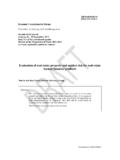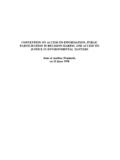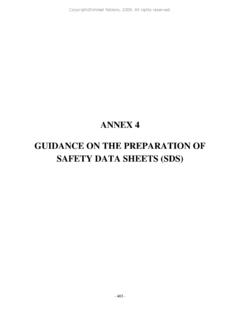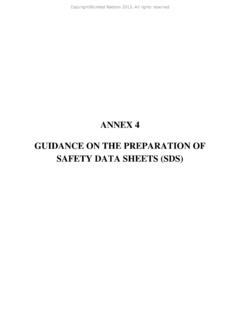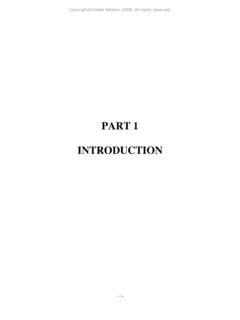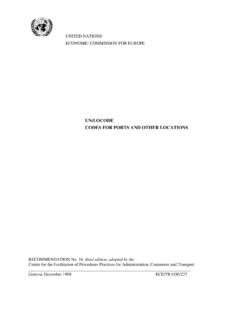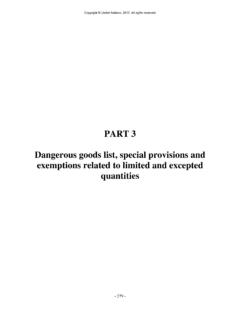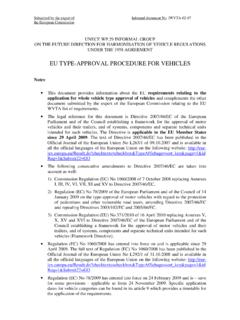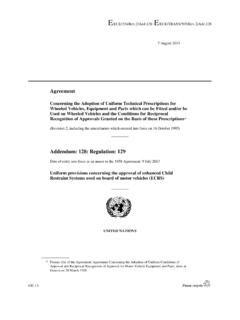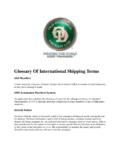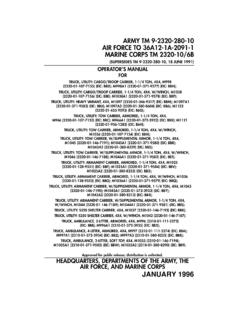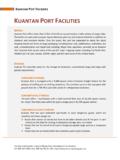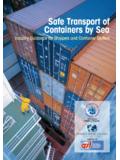Transcription of IMO/ILO/UN ECE GUIDELINES FOR PACKING OF …
1 I:\CIRC\MSC\ INTERNATIONAL MARITIME ORGANIZATION 4 ALBERT EMBANKMENT LONDON SE1 7SR Telephone: 020-7735 7611 Fax: 020-7587 3210 IMO E Ref. T3 2 May 1997 IMO/ILO/UN ECE GUIDELINES FOR PACKING OF CARGO TRANSPORT UNITS (CTUs) 1 The Maritime Safety Committee of IMO, at its sixty-seventh session (2 to 6 December 1996), approved the IMO/ILO/UN ECE GUIDELINES for PACKING of Cargo Transport Units (CTUs) which were prepared by the Working Group on Ship/Port Interface (SPI Working Group) in co-operation with the UN ECE Working Party on Combined Transport ( ), subject to editorial improvements by the UN ECE, ILO and IMO Secretariats, if necessary. The Committee instructed the IMO Secretariat to publish the GUIDELINES by means of an MSC Circular and publish them, in co-operation with the UN ECE and ILO, after endorsement by these two organizations.
2 2 The GUIDELINES were subsequently endorsed by the Inland Transport Committee of the UN ECE in January 1997 and by the Governing Body of the ILO in March 1997. 3 These GUIDELINES , which have been based on the existing IMO/ILO GUIDELINES for PACKING Cargo in Freight Containers or Vehicles, are applicable to transport operations by all surface and water modes of transport and the whole intermodal transport chain. 4 Member Governments and international organizations concerned are invited to bring the GUIDELINES , annexed hereto, to the attention of all parties concerned. 5 This circular revokes (IMO/ILO GUIDELINES for PACKING Cargo in Freight Containers or Vehicles), as amended by and ** I.
3 \CIRC\MSC\ ANNEX IMO/ILO/UN ECE GUIDELINES FOR PACKING OF CARGO TRANSPORT UNITS (CTUs) GUIDELINES FOR THE PACKING OF CARGO OTHER THAN BULK CARGO INTO OR ONTO CARGO TRANSPORT UNITS (CTUs) APPLICABLE TO TRANSPORT OPERATIONS BY ALL SURFACE AND WATER MODES OF TRANSPORT CONTENTS Preamble Scope Definitions 1 General conditions 2 Visual inspections prior to PACKING Exterior inspection Interior inspection 3 PACKING and securing of cargo Before PACKING PACKING and securing On completion of PACKING 4 Additional advice on the PACKING and securing of dangerous cargoes General Before PACKING PACKING and securing On completion of PACKING 5 Advice on receipt of CTUs 6 Basic principles for the safe handling and securing of CTUs General Lifting Containers on the ground CTUs on vehicles CTUs
4 On ships ANNEX Page 2 I:\CIRC\MSC\ 7 Training in PACKING of cargo in CTUs Regulatory authorities Management Personnel Training Recommended course syllabus - overview Annex 1 Condensation Annex 2 Labels, placards, marks and signs Annex 3 Consequences of overloading of containers Annex 4 List of relevant international organizations Annex 5 Illustrations of DO and DON T Annex 6 Topics to be included in a training programme for the PACKING and securing of cargoes in CTUs List of references ANNEX Page 3 I:\CIRC\MSC\ GUIDELINES FOR THE PACKING OF CARGO, OTHER THAN BULK CARGO, INTO OR ONTO CARGO TRANSPORT UNITS (CTUs) APPLICABLE TO TRANSPORT OPERATIONS BY ALL SURFACE AND WATER MODES OF TRANSPORT Preamble While the use of freight containers, swap-bodies, vehicles or other cargo transport units substantially reduces the physical hazards to which cargoes are exposed, improper or careless PACKING of cargoes into/onto such units, or lack of proper blocking, bracing and securing, may be the cause of personnel injury when they are handled or transported.
5 In addition, serious and costly damage may occur to the cargo or to the equipment. The person who packs and secures cargo into/onto the cargo transport unit (CTU) may be the last person to look inside the unit until it is opened by the consignee at its final destination. Consequently, a great many people in the transport chain will rely on the skill of such persons, including: - road vehicle drivers and other highway users when the unit is transported; - rail workers, and others, when the unit is transported by rail; - crew members of inland waterway vessels when the unit is transported on inland waterways; - handling staff at inland terminals when the unit is transferred from one transport mode to another; - dock workers when the unit is loaded or discharged; - crew members of the ship which may be taking the unit through its most severe conditions during the transport operation; and - those who unpack the unit.
6 All persons, such as the above and passengers, may be at risk from a poorly packed container, swap-body or vehicle, particularly one which is carrying dangerous cargoes. Scope These GUIDELINES , which are not all inclusive, are essential to the safe PACKING of CTUs by those responsible for the PACKING and securing of the cargo and by those whose task it is to train people to pack such units. Training is essential if safety standards are to be maintained. These GUIDELINES are not intended to conflict with, or to replace or supersede, any existing regulations or recommendations which may concern the carriage of cargo in CTUs. They do not cover the filling or emptying of tank containers, portable tanks or road tank vehicles, or the transport of any bulk cargo in bulk packagings.
7 ANNEX Page 4 I:\CIRC\MSC\ Definitions For the purposes of these GUIDELINES , cargo transport unit (CTU) has the same meaning as intermodal transport unit (ITU) and the following definitions apply: bulk cargoes means cargoes which are intended to be transported without any intermediate form of containment in bulk packagings or portable tanks; block train means a number of permanently coupled railway wagons, normally running directly between two selected terminals or entities without shunting; cargo means any goods, wares, merchandise and articles of any kind which are intended to be transported; cargo transport unit (CTU) means a freight container, swap-body, vehicle, railway wagon or any other similar unit; dangerous cargoes means packaged dangerous, hazardous or harmful substances, materials or articles, including environmentally hazardous substances (marine pollutants) and wastes, covered by the International Maritime Dangerous Goods (IMDG) Code; the term dangerous cargoes includes any empty uncleaned packagings; freight container means an article of transport equipment that is of a permanent character and accordingly strong enough to be suitable for repeated use.
8 It is designed to transport a number of receptacles, packages, unit loads or overpacks together from the PACKING point to its final destination by road, rail, inland waterway and/or sea without intermediate separate handling of each package, unit load or overpack. The word freight is not repeated throughout these GUIDELINES ; handling includes the operation of loading or unloading/discharging of a ship, railway wagon, vehicle or other means of transport; intermediate bulk container (IBC) means a rigid, semi-rigid or flexible portable packaging that: .1 has a capacity of not more than m3 (3,000) for solids and liquids; .2 is designed for mechanical handling; and .3 is resistant to the stresses produced in handling and transport, as determined by tests; intermodal transport unit (ITU) means a container, swap-body or semi-trailer suitable for intermodal transport; lift truck means a truck equipped with devices such as arms, forks, clamps, hooks, etc.
9 To handle any kind of cargo, including cargo that is unitized, overpacked or packed in CTUs; ANNEX Page 5 I:\CIRC\MSC\ maximum payload means the maximum permissible weight of cargo to be packed into or onto a CTU. It is the difference between the maximum operating gross weight or rating and the tare weight, which are normally marked on CTUs as appropriate; overpack means an enclosure used by a single shipper to contain one or more packages and to form one unit for convenience of handling and stowage during transport. Examples of overpacks are a number of packages either: .1 placed or stacked on to a load board such as a pallet and secured by strapping, shrink-wrapping, stretch-wrapping or other suitable means; or.
10 2 placed in a protective outer packaging such as a box or crate; PACKING means the PACKING of packaged and/or unitized or overpacked cargoes into CTUs; unpacking means the removal of cargo from CTUs; packaging(s) means receptacles and any other components or materials necessary for the receptacle to perform its containment function; packages means the complete product of the PACKING operation, consisting of the packaging and its contents as prepared for transport; responsible person means a person appointed by a shore-side employer who is empowered to take all decisions relating to his/her specific task, having the necessary current knowledge and experience for that purpose, and who, where required, is suitably certificated or otherwise recognized by the regulatory authority; ship means a seagoing or non-seagoing watercraft, including those used on inland waters; shunting means the operation when single railway wagons or groups of railway wagons are pushed to run against each other and be coupled together.
